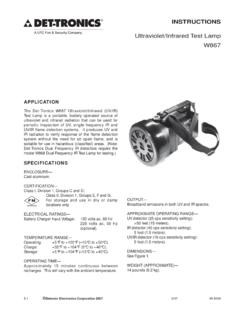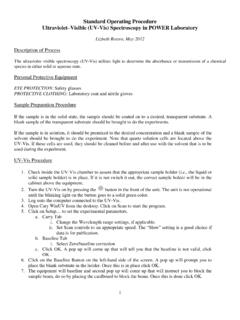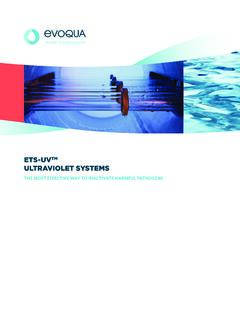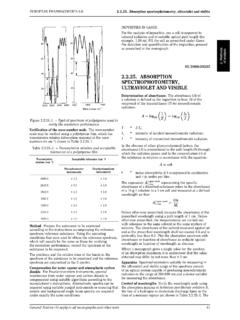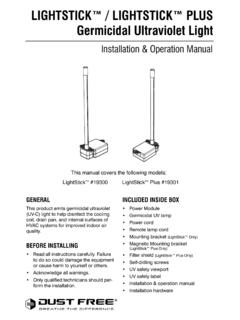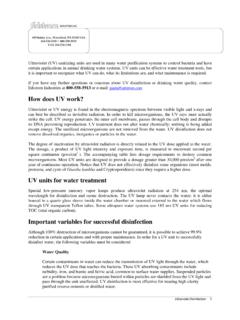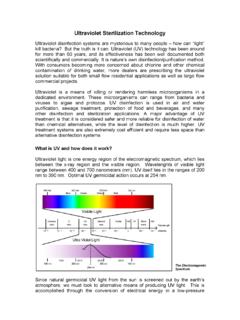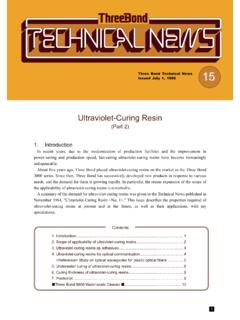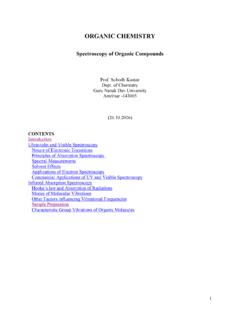Transcription of Studying the Mechanisms of Titanium Dioxide as Ultraviolet ...
1 Studying the Mechanisms of Titanium Dioxide asUltraviolet-Blocking Additive for Films and Fabrics by anImproved SchemeHongying Yang,1 Sukang Zhu,1 Ning Pan1,21 Center of Physics of Fibrous Materials, Dong Hua University, Shanghai 200051, China2 Division of Textiles and Clothing, Biological and Agricultural Engineering Department, University of California,Davis, California 95616 Received 5 August 2003; accepted 7 November 2003 ABSTRACT: Titanium Dioxide (TiO2) has good Ultraviolet (UV)-blocking power and is very attractive in practical ap-plications because of such advantages as nontoxicity, chem-ical stability at high temperature, and permanent stabilityunder UV exposure, for example. Development of nano-science and -technology provides new ways for better treat-ment for UV-resistant films and fabrics using TiO2. How-ever, the exact Mechanisms of TiO2as a UV-blocking addi-tive are still not very clear, and researchers hold differentviews on this issue.
2 The aim of this investigation was tostudy systematically the Mechanisms of TiO2as a UV-block-ing additive for films and fabrics. To achieve this goal, theconventional scheme describing light interactions with fab-rics was revised based on more recent progress in opticaltheory, and special experiments and analytic methods wereused in the investigation. Several effects attributed to thenanoscale additives were identified. Moreover, detailedanalyses based on the results yielded a few importantsuggestions useful in developing or improving both inor-ganic UV-blocking agents and the UV-protective films andtextiles. 2004 Wiley Periodicals, Inc. J Appl Polym Sci 92:3201 3210, 2004 Key words:inorganic UV-blocking agents; additives; films;adsorption; light scatteringINTRODUCTIONMore frequent reports of skin cancer have made peo-ple increasingly aware of the danger of prolongedexposure to Ultraviolet (UV) rays, which account forabout 6% of the terrestrial sunlight and, under exces-sive doses, is proved to cause erythema, certain skincancers, keratitis, and cataracts.
3 Textiles and sun-blocking creams are the common choices to shieldagainst UV radiation, although UV radiation alsoweathers and degrades the textiles. Consequently,new UV-blocking agents have been developed to addto or to improve the UV-protective function of textiles,plastic films, and other related are both organic and inorganic UV organic blockers are also called UV absorbersbecause they mainly absorb UV rays. Inorganic UVblockers are usually certain semiconductor oxidessuch as TiO2, ZnO, SiO2, and Al2O3, for with the existing organic UV absorbers, theinorganic UV agents are more preferred because oftheir unique features including, among others, non-toxicity and chemical stability under both high tem-perature and UV-ray , the mechanism of UV-blocking functionof inorganic materials is so far not very clear andresearchers hold different views concerning its TiO2, for example: some investigators believethat it provides good UV protection by reflectingand/or scattering most of the UV-rays through itshigh refractive ,3 Others believe that it absorbsUV radiation because of its semiconductive 6 Still others claim that, of a pile of TiO2powder,only the nanosize particles absorb UV radiation,whereas the submicrometer-size particles do very the mixed and often conflicting views, itappears desirable for a thorough investigation on article reports the systematic investigation ofthe exact Mechanisms of TiO2as an inorganic UV-blocking additive for fabrics.
4 To obtain more accurateresults, an improved scheme on light object interac-tions based on recent progress in optical theory wasproposed, describing how fabrics or films react to thelight illuminating on them. As shown below, this ap-proach yields more informative data than do the con-ventional approaches and also has the potential toprovide deeper understanding and thus improve theoptical properties of textiles. Naturally, the new meth-ods described in this article are applicable for studyingCorrespondence to:S. Zhu of Applied Polymer Science, Vol. 92, 3201 3210 (2004) 2004 Wiley Periodicals, Mechanisms of other inorganic UV-blocking addi-tives for OF UV-PROTECTIVE PROPERTYOF FABRICSA UV-ray, like visual light (VIS), is a segment of theelectromagnetic spectrum, with a wavelength rangingfrom 100 to 400 nm, and is conventionally subdividedinto three bands: UVA (320 or 315 to 400 nm), UVB(290 to 315 or 320 nm), and UVC (100 290 nm). Theterrestrial solar UV received consists of only UV withwavelength 290 400 nm because UVC and some UVBare absorbed by the stratospheric ozone in the earth recent years, investigators and manufacturershave paid increasing attention to understanding thesolar UV-protective properties of textiles.
5 Several re-lated standards have been published by Australia/New Zealand, Europe, and the United States, 10 Among these standards, UPF, T_UVA, andT_UVB are the commonly adopted so-called UV-protection factor (UPF) is definedasUPF 290400E S d 290400E S d (1)where represents the wavelength in nm,E is therelative erythemal effectiveness,S is the solar UVspectral irradiance in W m 2nm 1(data from Albu-querque, NM are used in this study), is the spectraltransmittance of the specimen, andd is the wave-length increment in is constant, three more indices can becalculated byT_UVA 1m 315400 T_UVB 1n 290315 T_VIS 1k 400760 (2)where T_UVA, T_UVB, and T_VIS (in %) are themeans of transmittance under UVA, UVB, and VIS(400 760 nm); andm,n, andkstand for the number ofmeasurement points for UVA, UVB, and VIS, fact, the UPF value represents how much longerpeople can become exposed wearing clothing, versusnot wearing it, until the skin develops IMPROVED SCHEME ON FABRIC ANDLIGHT INTERACTIONSC onventionally, a light illuminating on fabric was di-vided into three parts according to the resulting lightdistribution: reflection, absorption, and more detailed division was made by subdividingthe transmission part into a component that passesthrough the pores and a diffused or scattered description is useful in evaluating the op-tical properties of fabrics, but is not so useful in ana-lyzing the origin of fabric optical properties.
6 This ar-ticle thus advocates an improved scheme based onoptical theory, and this study focuses on both plasticfilms and textile examining the interactions between light andfabrics, the incident light normally illuminating a fab-ric is divided as follows (see Fig. 1): part of the lightturns into regular reflection (including specular anddiffused reflection) at the interface, marked asdr; an-other partaenters into the fabric and is absorbed bythe material; some passes through the fabric with di-rection unchanged, recorded asdt; whereas anotherpart enters into the fabric and is scattered because ofthe uneven structure of the fabric and/or the additivesin the fabric. Of the scattered light, the backward-scattered light generates the same effect as the reflec-tion, termed scattered reflectionsr, whereas the for-ward-scattered light also passes through the fabric;portions maintaining the same direction as that of theincident ray are recorded asdt; the rest, deviating fromthe incident direction, are termed as diffused (or scat-tered) can be seen that the improved scheme adds thefactor of scattered light to the analysis, which is thensubdivided into scattered reflection, direct transmis-sion, and diffused transmission according to their finaleffects.
7 In short, the normal incident light is eventuallytransferred into five portions, as follows: regular re-flection, scattered reflection, absorption, direct trans-mission, and diffused transmission. As a matter ofFigure 1 Model of fabric light , ZHU, AND PANfact, scattering is an indispensable part of the interac-tions between a medium and light, and it plays animportant role in determining the optical behavior to the new scheme, the following rela-tions hold:R dr sr A aT dt st I R A T(3)whereRis the total reflection,Ais the absorption,Tisthe total transmission, andIis the incident ray, so that R/I T/Is st/I A/I 1 (4)where is the reflectance, is the transmittance, s isthe scattered transmittance, and is the these variables, , , and s can be measuredusing a spectrophotometer with an integrating sphere,and can then be calculated by eq. (4). Figure 2 showsthe path of a 110-mm integrating sphere in a Cary500 spectrophotometer from Varian Technologies(Palo Alto, CA).
8 11 The new scheme as well as the characteristic fea-tures , ,s , and are fundamental in identifying andanalyzing the contributions of various interactions be-tween light and fabric containing TiO2,soastoex-plore the true Mechanisms of TiO2as a UV-shieldingadditive. Further, they are of great advantage, asshown later, in Studying fabric optical behaviors toexplore new methods in improving or adjusting theoptical properties of and testsFour commercial TiO2powders, B, D, H, and P wereused in this study. To obtain reliable data, severalimportant characteristics of the powders themselveswere , the crystallinities of the powders were deter-mined through X-ray diffraction (XRD) using aDMAX/rB diffractometer (Rigaku Co., Tokyo, Japan).The XRD patterns are given in Figure 3 showing thatD, P, and H are rutile TiO2, whereas B is an , the diffraction peak of D is clearlybroader than that of the others, and its mean diameter,calculated by using Scherre s eq.
9 (7), was about 32 , using a nitrogen absorbance meter, modelJB-1 (made in China), the Brunauer Emmett Teller(BET) specific surface areas of the powders were mea-sured, ranging from 139, 11, , and to less than 1 m2g 1for D, P, B, and H, respectively. Under the as-sumption that the particles are spherical, their averagediameters were thus calculated. D is about 32 nm indiameter, consistent with the result calculated byScherre s equation with the line broadening. B and Pare in the submicrometer range, although B is slightlysmaller than P; and H is at the micrometer , the primary diameter of D was also mea-Figure 4 SEM micrograph of sample 2 Light path of integrating sphere in Cary 500 3 XRD patterns of TiO2of different types: H, B, P,and UV-BLOCKING ADDITIVE3203sured by a scanning electron micrograph and is actu-ally 100 nm (see Fig. 4). Furthermore, the size dis-tribution by number for powder D in deionized waterwas analyzed by a Zetasizer3000HS (Malvern Instru-ments, Worcestershire, UK) using the laser-diffractionmethod, shown in Figure 5.
10 A test summary for thefour powders is listed in Table materials were also used in this investi-gation, including a polymer binder from NationalStarch and Chemical (Berkeley, CA), marked as j be-low; an ordinary commercial organic UV absorberused as a reference, denoted as O, as well as somecotton fabrics are listed in Table of the TiO2composite filmsTiO2powders were dispersed in deionized water andstirred with ultrasonic agitation (20 kHZ) for 5 , the binder j was mixed uniformly into a sol orsuspension for 5 min by ultrasonic stirring as amounts of these mixtures were applied ontoa level glass sheet, and solidified into films at roomtemperature. The films were then peeled off carefullyfrom the glass and placed into sample holders andcured under standard conditions for 24 h before test-ing. Table III provides details concerning all the films,and special care was taken during the preparation toensure their consistency. The weight percentages inTable III represent the ratio of powder to the purebinder.
